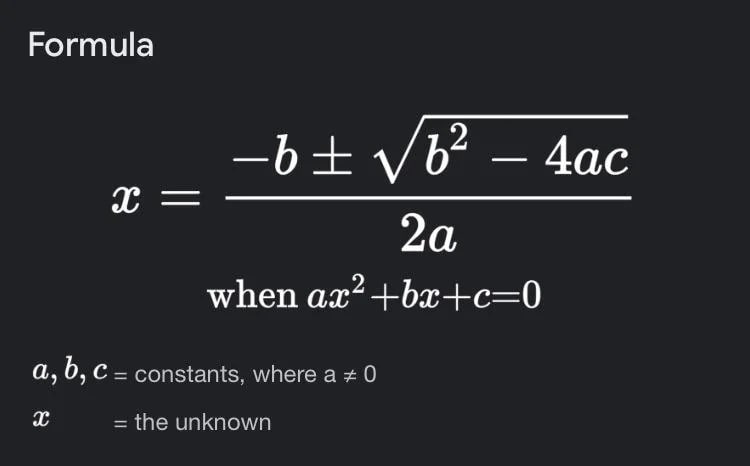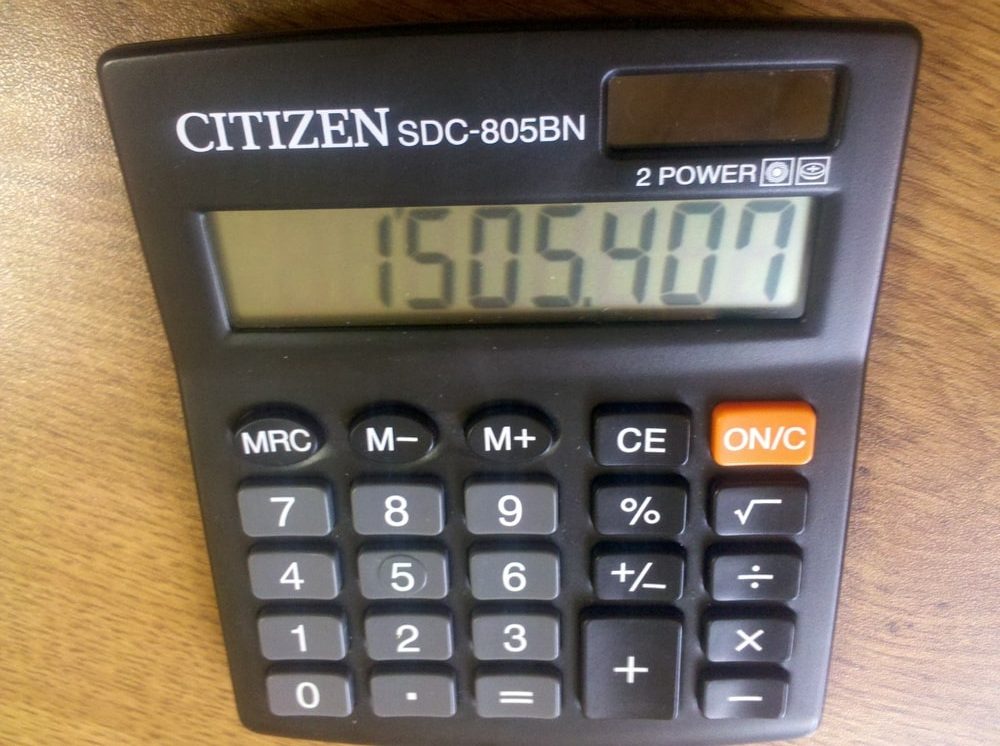Quadratic Equation Calculator
A Quadratic Equation Calculator is a powerful tool designed to solve quadratic equations quickly and accurately. Whether you’re a student, a professional, or someone brushing up on algebra, this calculator simplifies the process of finding solutions to second-degree polynomial equations. In this article, we’ll explore quadratic equations, how to use the calculator effectively, its underlying mechanics, features, and the importance of the discriminant in understanding solutions.
Results:
What is a Quadratic Equation?
A quadratic equation is a polynomial equation of degree 2, typically expressed in the standard form:
$$ax^2+bx+c=0$$Here:
- a, b, and c are constants, with a≠0
- x is the variable.
The term “quadratic” comes from the Latin word quadratus, meaning square, as the variable x is squared. They have numerous real-world applications, including physics (e.g., projectile motion), engineering, and economics.
Roots
The solutions are called its roots. These roots can be:
- Real and distinct (two solutions),
- Real and repeated (one solution),
- Complex (no real solution).
The roots are often found using the formula:

Understanding this formula is critical for solving equations manually or through a calculator.
Why Are These Equations Important?
They are foundational in mathematics because they describe relationships involving squared terms, which appear frequently in nature and science. Their study builds essential problem-solving skills and helps understand more complex mathematical concepts like calculus and differential equations.
Real-World Applications
Quadratic equations are not just theoretical; they have numerous practical applications across various fields. In physics, they are essential for calculating projectile motion trajectories, such as determining the path of a ball thrown into the air or predicting where artillery shells will land. Interestingly, this same principle underlies the mechanics of the popular casino game Plinko, where players drop chips down a pegged board, and the chips follow a path similar to projectile motion, bouncing randomly towards prize slots at the bottom.
In engineering, quadratic equations assist in designing parabolic structures like bridges or satellite dishes, ensuring optimal strength and functionality. Finance professionals rely on these equations to model profit maximization or cost minimization scenarios, helping businesses determine the ideal pricing strategies or production levels to achieve maximum profitability. Biologists also utilize quadratic models to forecast population growth under specific conditions, allowing them to anticipate changes in ecosystems or manage conservation efforts effectively.
Beyond these fields, quadratic equations are integral in areas as diverse as agriculture—where they help optimize crop allocation—and astronomy, aiding scientists in describing planetary orbits and galaxy formations.
How to Use the Calculator
Using a quadratic equation calculator is straightforward. Follow these steps:
- Input the coefficients: Enter the values of a, b, and c from your equation (ax2+bx+c=0).
- Press calculate: The calculator processes the inputs using the quadratic formula.
- View results: The calculator displays the roots, whether they are real or complex.
For example:
- For x2−3x−4=0
- a=1,b=−3,c=−4), the calculator will return two real roots:
- x=4 and x=−1.
How Does the Calculator Work?
A quadratic equation calculator solves by using the formula:
$$x = {-b \pm \sqrt{b^2-4ac} \over 2a}$$Key Steps:
- Calculate the discriminant b2−4ac:
- Determines the nature of the roots.
- If $b^2−4ac>0$: Two distinct real roots.
- If $b^2−4ac=0$: One real repeated root.
- If $b^2−4ac<0$:Two complex roots.
- Compute square root and divide:
- Determines the nature of the roots.
- The calculator computes
- $b^2−4ac$ and applies it to find both solutions (+ and −).
- Output solutions:
- Displays results in simplified form, including complex numbers if necessary.
Advanced calculators may also graphically represent solutions or provide step-by-step calculations for better understanding.

Features of the Calculator
Today’s calculators incorporate so many features for better user experience:
- Works with all types of radicands: Both real radical and all complex roots are displayed.
- Interactive operations: Showing intermediate answers for lessons is a feature on some calculators.
- Visually interactive: Illustrates the condition of a parabola relative to the x-axis, whether it intersects or does not touch.
- Error alerting: Notifies the user when invalid inputs are made or a=0
- Calculative speed and precision: System can solve the algebraic equations by itself in a split second.
It follows that such calculators are extremely useful for students and for engineers dealing with algebraic equations among other professionals as well.
Understanding the Discriminant
The discriminant is a mathematical term that is very essential for the solution of any quadratic equation. Description: The discriminant is derived from the formula as follows:
$$D=b^2−4ac$$This value appearing below the square root, also called structural, determines the resolve’s structure and quantity. It helps to analyze how the solution is going to behave or what sort of solutions one is going to get without solving it completely. Such characteristics make it more valuable in mathematics and other complexities.
Particularly for the discriminant it is important to know because it allows to study the graph of the equation. The roots are equal to the x – axes cut of the graph of the function which is parabolic. The discriminant makes it possible to analyze how this parabola is positioned with respect to the x-axis – whether it cuts it twice, one or not at all.
| Discriminant (D) | Nature of Roots | Description |
|---|---|---|
| D>0 | Two distinct real roots | The parabola crosses the x-axis twice. |
| D=0 | One repeated real root | The parabola touches the x-axis once. |
| D<0 | Two complex roots | The parabola does not intersect the x-axis. |
For example:
- For x2+4x+4=0
- $D=b^2−4ac=(4)^2−(4)(1)(4)=0$ This yields one repeated root.
- For $x^2+x+1=0$
- $D=x^2−4ac=(1)^2−(4)(1)(1)=−3<0$ This results in two complex roots.
The discriminant not only aids in solving equations but also helps understand their graphical behavior.
Importance of Understanding Discriminants
Understanding discriminants is essential efficiently and interpreting their solutions correctly. It allows mathematicians and professionals to quickly determine whether has real or complex solutions and how these solutions relate to practical scenarios.
The discriminant not only determines the type of roots but also helps professionals and mathematicians understand how these roots relate to real-world problems. For example, in physics, a positive discriminant might indicate two possible times for an object to reach a certain height, while a negative discriminant might suggest that a solution is not feasible in real-world conditions.
Conclusion
A Quadratic Equation Calculator is an invaluable tool for solving second-degree polynomial equations efficiently and accurately. By leveraging mathematical algorithms like the formula, it eliminates manual errors and saves time for users across various fields—from students learning algebra to professionals tackling engineering problems.
Understanding concepts such as roots, discriminants, and how these calculators work enhances your ability to approach confidently. Whether you’re solving for real-world applications or academic purposes, this tool simplifies even complex problems into manageable solutions.
Frequently Asked Questions (FAQs)
It is a second-degree polynomial expressed as $ax^2+bx+c=0$, where a≠0.
Yes, when the discriminant, there are no real solutions—only complex ones.
Most online calculators are highly accurate as they use precise mathematical algorithms to compute results instantly.
No, this calculator specifically solves second-degree polynomials Higher-degree polynomials require different methods or tools.
The discriminant helps determine whether a quadratic equation has real or complex roots and provides insights into its graphical representation.